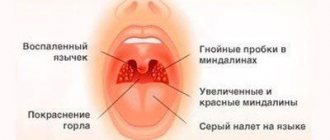Sinusitis is accompanied by numerous symptoms, among which there are even such unusual manifestations as nausea, toothache, chills, etc. Some have never experienced such manifestations during inflammation of the maxillary sinuses, while others, on the contrary, have encountered this phenomenon for one reason or another. The question arises: can nausea occur with sinusitis? If yes, then in what cases? What could this sign indicate and what could it lead to? You will also learn all the necessary information about other symptoms of the disease that are not always found, but are nevertheless observed in certain situations: sneezing, high blood pressure, sore throat, etc.
Sometimes sinusitis is accompanied not only by a runny nose and headaches, but also by a feeling of nausea
Symptoms of acute sinusitis in adults
- Pain may be manifested by one of the following signs, or two or three of them may be present at once:
- Pain under the eye or paranasal area. The pain intensifies when pressing on this place. Its intensity increases in the evening, when discharge accumulates in the sinus, and passes by the morning, especially if the person slept on the opposite side. Redness and swelling of the infraorbital area may also be noted, but this is not a necessary symptom.— The pain can be localized in the upper jaw area. One gets the impression that the tooth hurts, especially since biting with the molars on this side actually becomes more painful. This occurs due to pressure from the contents of the sinus on the trigeminal nerve, which innervates both the infraorbital region and the upper teeth.
- In addition to pain, nasal breathing may be impaired. It is usually impossible to breathe through the nose without the use of vasoconstrictor drops.
- Discharge from the nose may appear in different colors. This is an optional symptom, since if the anastomosis between the sinus and nose is blocked by viscous contents, and the patient did not use vasoconstrictor drops, then the discharge remains in the sinus without coming out. Sometimes it happens that in the morning a copious amount of thick discharge comes out of the nose, but during the day nothing is released, while the symptoms increase.
- Increased body temperature - appears in almost all cases of sinusitis.
- Weakness, drowsiness, loss of appetite are signs of intoxication. There may also be nausea. Vomiting is not typical. If you have a headache and vomiting that is not related to food, and before that a copious amount of snot came out of your nose, immediately seek medical help: this can be a rather dangerous complication of sinusitis - meningitis.
- Nasal voice.
High blood pressure
The question of whether blood pressure can increase with sinusitis is quite complex and controversial. Doctors claim that increased blood pressure has nothing to do with this disease, but such situations are observed, and it makes no sense to deny this fact.
Pressure during sinusitis increases if a person has a tendency to hypertension
Experts agree that such a sign is observed if a person had a tendency to hypertension even before the development of sinusitis. Thus, the inflammatory process in the paranasal sinuses is only a provoking factor that contributes to the exacerbation of hypertension.
In this situation, it is important to seek medical help, and consult not only with an otolaryngologist, but also with a therapist or other specialist with whom you are registered.
It is necessary to continue treatment of sinusitis, but do not forget about high blood pressure, taking the medications that the doctor prescribes. In no case should you delay treatment, as this can lead to dire consequences.
Symptoms of chronic sinusitis in adults
If you have such symptoms, especially if you know that you have a deviated nasal septum, or you are suffering from frequent caries, you should undergo an examination by an ENT specialist and a dentist, and take an x-ray of all your teeth (this is called an orthopantomogram). Sometimes it is enough to cure or remove just one tooth to rid yourself of the source of microbial toxins. This is also important in terms of preventing serious diseases of internal organs, especially the kidneys.
Source: https://www.infmedserv.ru/stati/simptomy-gaymorita-u-vzroslyh
General pharmacology
Sinusitis is an acute or chronic inflammation of the mucous membrane of the maxillary cavity, most often caused by the transition of the inflammatory process from the nasal mucosa. It often occurs with influenza, measles, scarlet fever, and caries of the molars of the upper jaw. Signs of purulent inflammation of the mucous membrane of the maxillary cavity (empyema) are the outflow of pus from the corresponding nostril, which intensifies when the patient lies on the opposite side or when lying on his stomach with his head down, infraorbital neuralgia and swelling of the cheek. All signs are very rare at the same time; usually one of them predominates. And swelling of the cheek always begins with chills, fever, pain in the upper jaw, swelling of the cheek and a sensation as if the teeth are lengthening. The tumor is especially noticeable in the area from the canine to the third molar.
In acute sinusitis, headache, pain in the cheek area, toothache, severe runny nose, discharge of mucus or pus from one nostril, sometimes fever, chills and general poor condition are noted. With chronic sinusitis, patients complain of stuffiness of one half of the nose, discharge of pus from it, headaches, general weakness and fatigue.
Inflammation of the maxillary or other paranasal sinuses is called the general medical term “sinusitis.” Inflammation of the mucous membrane of the frontal sinuses is expressed in severe headaches in the forehead. Usually it is always accompanied by a runny nose. The pain is usually concentrated in the depths of the forehead, partly in the depths of the eyes or in the eyelid area and is sometimes constant, sometimes intermittent, and is of a neuralgic nature. The pain increases significantly with mental stress, coughing, sneezing, pressure on the frontal bones, bending the body; sometimes accompanied by nausea and vomiting (what causes vomiting?). But most often the pain is localized at the root of the nose or deep in the eye and has a pressing or boring character. At the same time, the appearance of mucous discharge from the corresponding nostril or purulent fluid or crusts is observed. In this case, patients complain of obstruction of the other nostril and loss or weakening of the sense of smell.
Inflammation of the sinus of the main bone can be suspected if the patient suffers for a long time from the discharge of thick pus (sometimes odorous, sometimes not) from one nostril, with the formation of crusts on the nasal mucosa. Pus is secreted partly from the nose, partly from the pharynx, and its secretion intensifies when the head is tilted forward. Such patients suffer from pain in the crown area, pain spreads to the back of the head, supraorbital region and cheek of the corresponding side. Sometimes patients also complain of dizziness and stagger a little when walking. With chronic inflammation of the paranasal sinuses, peculiar growths - polyps - can form on the nasal mucosa. They are benign neoplasms of mucous consistency, round or oval in shape, grayish or pale red in color, sitting on a stalk and ranging in size from a pea to an acorn. Papillomas can also be found in the nose - tumors that have a papillary base that penetrates deeply into the tissue. They are very rich in blood vessels and are prone to rapid swelling and proliferation. Treatment is achieved surgically. Redness of the nose is almost always associated with inflammation or suppuration in the nasal cavity. Sometimes redness is caused by poor circulation due to poor diet. At the same time, you should exclude spicy foods from food, such as vinegar, mustard, and stop taking very hot foods, including coffee and tea. Chronic redness occurs from chronic gastric diseases, from constant, long-term constipation, and in women also from frequent pregnancies and gynecological diseases. In such cases, the redness is almost invisible and only occasionally gives the nose and cheeks a lilac or reddish color. In this case, it is useful to wash your nose every day with a 5% alum solution. But most often, redness of the nose is a disease of drunkards. If urgent measures are not taken, then the entire nose in a short time becomes covered with a mass of tortuous veins, engorged with blood and giving the nose a bluish tint. From this rush of blood, the nose gradually becomes thicker, more voluminous, the sebaceous glands in it grow, the nose gets a greasy shine and becomes like a pear.
• Boil water in a saucepan, pour in 0.5 teaspoons of propolis tincture with alcohol. Cover your head and breathe in the steam.
Crazy cucumber, budra, drop cap, speedwell, mustard, spruce, hare cabbage, St. John's wort, Kalanchoe, potatoes, coltsfoot, soapwort, mint, sea buckthorn, primrose, thyme, tricolor violet, cyclamen, garlic, celandine, horse sorrel, Apple vinegar.
Source: https://medik-lif.ru/zabolevaniya-nosa-i-ego-pridatochnyx-pazux/217
Are nausea and vomiting a symptom of sinusitis?
Sinusitis is an inflammation of the maxillary sinuses.
The disease begins acutely with a rise in temperature, chills, weakness, lethargy, and apathy. Nasal congestion is noted, sinus pain occurs from the first days, later severe headaches and nasal discharge may occur. If you find such phenomena in yourself and your loved ones, you should consult a doctor for diagnosis and prescribing proper treatment. Nausea with sinusitis is not observed, with the exception of isolated cases when, with any increase in body temperature, a person experiences dizziness, nausea and vomiting. But if such manifestations have not happened before, you should urgently seek qualified help; delay significantly aggravates the condition. Vomiting during sinusitis indicates the occurrence of complications of the disease or severe intoxication of the body.
Nausea with sinusitis in adults can occur against the background of damage to the central nervous system: meningitis, encephalitis or blood poisoning (sepsis); such a symptom is not typical for inflammation of the sinuses.
Can you feel sick with sinusitis? Yes, if the body succumbs to infection, which leads to the development of severe complications. Vomiting that occurs during treatment of sinusitis is an undeniable reason to urgently call an ambulance.
The most dangerous complication, the most common companion to sinusitis, accompanied by vomiting, is meningitis.
Can you feel sick with sinusitis?
Question:
Hello, my name is Ekaterina. My nine-year-old son was diagnosed with acute bilateral sinusitis. We are on the second day of treatment, and my son began to complain that he was feeling nauseous. Tell me, can you feel sick with sinusitis? Or maybe these are symptoms of another disease?
Answer:
Hello, Ekaterina. Nausea itself is not a symptom of sinusitis. But if the acute course of the disease is accompanied by headache or dizziness caused by the pressure of purulent masses on the walls of the sinus, then in this condition there may well be a feeling of gagging.
In this case, the use of non-steroidal anti-inflammatory drugs such as aspirin or citramone is appropriate. They will relieve the headache, and along with it the feeling of nausea will go away.
You should also read the instructions for the medications used. Perhaps some of them have corresponding side effects. But this is not a reason to stop treatment, if your child copes well with gag reflexes, you need to complete the treatment, after which the side effects will go away. If not, you should talk to your doctor about changing the drug that is causing discomfort.
Sneezing, runny nose and cough
Symptoms that are usually present with colds, such as coughing, runny nose and sneezing, may also appear with sinusitis. Such signs should not cause confusion, because they are the body’s protective reaction to external stimuli. The respiratory system independently tries to get rid of dangerous germs and bacteria, which results in coughing, sneezing, etc.
Sneezing is a protective reaction of the body to external irritants during sinusitis.
To help the body get rid of the infection, the following treatment methods should be used:
- Decongestants. Such remedies reduce swelling of the nasal mucosa and help clear the sinuses of purulent contents.
- Rinsing the sinuses. For this, sea salt or soda is used, sometimes you can use decoctions of medicinal herbs. In this case, it is important to carry out the procedure correctly for it to be effective.
- Antibacterial medications. These include Amoxicillin, Ceftriaxone, Azithromycin and other drugs that can only be taken after consultation with your doctor.
It is important to fight not the sneezing or runny nose itself, but the infection that caused the appearance of such symptoms of the disease.
Why do you often get headaches when you have a runny nose?
There are several options on how you can reduce or eliminate headaches, even regardless of the underlying disease. However, before you begin to relieve headaches, it is advisable to clearly establish the cause of all symptoms. These reasons may not be the most serious, associated with a common cold, but may be quite severe, indicating that inflammation of the sinuses is occurring. Sometimes it becomes impossible to eliminate individual symptoms; it is necessary to carry out adequate comprehensive treatment - all symptoms in this case disappear as you recover. To diagnose the condition and identify certain health problems, as well as to prescribe treatment, you should consult a doctor.
The easiest way to cause a runny nose and headache is a cold. There is no particular cause for concern, although other symptoms are also observed:
Young children get sick much more often than adults. The reason for this is the child’s still weak immunity, which poorly protects him from viruses and infections. A fragile body, when hypothermic, lets in microbes that cause diseases such as bronchitis, acute respiratory viral infections, influenza, and acute respiratory infections.
Ekatrina . I'm not a doctor. But vomiting may be due to accumulated mucus.
How do you treat a runny nose? Are you allergic to anything? Do you treat your child at home or does he continue to go to kindergarten?
I also thought about vomiting because of snot - but why such an interval - not immediately after waking up, but later.
Vomiting in kindergarten can also be neurogenic. My child was diarrhea at the entrance to the kindergarten (he was small, a toddler), we were not accepted into the group, we were examined for a medical group - but there was no infection. And when we arrive at kindergarten - crying, roaring and “porridge” in our underpants. We left the kindergarten.
in short, a lot of but. Maybe the child is crying and doesn’t want to go to the garden. And during hysteria there is a urge to vomit.
Ekatrina . weren't you tested for worms?
Pokklya wrote: neurogenic character.
We were also in the adaptation period, the first month after arriving at the kindergarten we ran to pee 5 times. Then it all went away.
Ekatrina . I personally, when I came to kindergarten as a child, I had the urge to vomit every morning. I remember it very well. I felt terribly sick. But only in kindergarten. Sometimes there was vomiting.
nausea with sinusitis
Professional retraining program. A physiotherapist and a physiotherapist is a physiotherapist who is an expert in the treatment and
Any tumor is an abnormal growth of cells that serve no purpose. A malignant tumor is a tumor whose properties are most often (as opposed to the properties
Normal blood pressure in adults In men Normal blood pressure in men 20-40 years old is 123/76 High blood pressure during pregnancy can be a sign of serious pathologies. What you need to know about
Medical use of the red Red brush is a wonderful gift. The Red brush, in its Red brush Application (the fact is that the red brush has a stimulating
Two magical people, Do's and Don'ts, help a Baby who is left at home alone. YOU CAN GET PREGNANT FROM LUBRICANT. Is it possible to get pregnant from a man's secretions (lubricant).
From us you can buy urbech made from nuts that have not been subject to heat treatment, without sugar. Agrarian bulletin board Grain Online: prices, supply and demand for
Free thyroxine (S-fT4) T4 (thyroxine, tetraiodothyronine) is the main hormone of the thyroid gland. The T3 hormone is formed as a result of the combination of mono- and diiodotyrosine molecules.
Whooping cough convulsive cough in a child, symptoms, causes, treatment Possible causes. Cough to the point of vomiting in a child develops with: whooping cough and parawhooping cough;
The main methods, methods and types of temporary stopping of various types of bleeding. A temporary method of stopping bleeding is used to provide first aid for
Quinoa, but in times of famine such food was the only salvation. Lebeda saved thousands of Leningraders in the spring of 1942. In the second half of summer and autumn
Source: https://www.aptekasib.ru/59435.adp
High blood pressure and body temperature 37 and above: causes
High blood pressure and a temperature of 37 degrees are a very alarming sign indicating the presence of some disease.
Often, when these symptoms appear at the same time, people are treated for colds, flu and other illnesses caused by the virus. However, such therapy can pose health risks.
The fact is that hypertension and a temperature of 37 degrees most often signals a malfunction of the cardiovascular system.
If there is a high temperature, high blood pressure and additional symptoms, the doctor can diagnose kidney damage, disruption of the internal organs of the endocrine system and the autonomic system.
When the first signs of the disease appear, you should immediately seek help from a doctor and refrain from self-medication so as not to cause the development of complications.
When is high blood pressure considered a symptom?
As you know, the normal temperature ranges from 36 to 37 degrees. When the temperature rises above 37, the body reports the presence of problems in the functioning of the body.
In some cases, hypertension may not provoke an increase, but, on the contrary, a decrease in temperature below 36 degrees. Then the doctor diagnoses a vegetative disorder.
Elevated temperature over 37 degrees and high blood pressure can be especially dangerous for people with heart problems. But such symptoms do not always indicate the presence of problems in the functioning of the cardiovascular system; in this case, a rapid heartbeat appears with high blood pressure. High blood pressure is sometimes just a symptom. A similar condition is often observed when internal organs are damaged in the form of malfunction:
- Adrenal glands;
- Thyroid gland;
- Kidney.
Adrenal gland dysfunction
on
The kidney is responsible for regulating blood pressure. In a certain situation, a person may develop a pheochromocytoma in the form of a tumor in the area of the adrenal gland; such a formation begins to actively produce adrenergic hormones, similar to stress hormones.
If in healthy people such substances are rarely produced and only in the event of a stressful situation, then in the presence of a tumor the production of hormones occurs constantly, and an increased amount of substances is released. This causes an increase in blood pressure. Additionally, the patient may have a body temperature above 37 degrees.
To identify the disease, the doctor must prescribe a urine test for the level of adrenergic hormones.
Thyroid dysfunction
When the thyroid gland intensifies, the active production of certain hormones occurs, which have a negative effect on the functioning of the cardiovascular system. The heart begins to beat rapidly, the blood volume increases sharply, and fever appears.
If there are symptoms in the form of increased blood pressure, the doctor will additionally prescribe a test of thyroid hormones and an ultrasound examination.
Kidney dysfunction
When the renal artery in the kidneys narrows, a person’s blood pressure increases greatly and the temperature rises above 37 degrees. In this case, the required amount of blood does not enter the kidney cavity, the pressure decreases and the production of a certain substance is activated, which retains fluid and increases blood pressure.
This condition usually cannot be treated with standard antihypertensive drugs. The doctor prescribes an ultrasound examination of the renal artery, due to which it is possible to identify exactly where the narrowing is located.
Future treatment involves dilating the blood vessel. The procedure is carried out by puncture in the thigh area, the narrow passage is inflated and enlarged.
After therapy, the kidney can receive the proper amount of blood, blood pressure returns to normal, and the temperature drops to 37 degrees or below.
Headache with a runny nose
With the development of rhinitis, a headache may appear even before signs of a runny nose appear. On the other hand, this symptom can also be a sign of a serious illness.
Headache during a cold appears due to infection in the paranasal sinuses. In this case, the person experiences fever and chills.
During the flu, the headache is worse, especially around the eyes and forehead. If unbearable head pain is accompanied by vomiting, nausea and very high fever, these are signs of a serious illness. Therefore, without hesitation, immediately seek help from the hospital.
Also, your head may begin to hurt due to swelling of the nasopharynx. This is the result of making it difficult to breathe through the nose and forcing one to breathe through the mouth.
Depending on which sinuses the infection has entered, sinusitis is divided into several types.
Ethmoiditis
Sinusitis develops as a result of inflammation of the maxillary sinuses. As a result, compressive pain is observed in the forehead and temples. When a person tilts his body down, the pain intensifies. Some patients notice that their cheeks are swollen.
Oxygen initially enters human organs and tissues in most cases through the nose. Accordingly, if nasal breathing becomes difficult, which is natural for a runny nose, then other processes associated with blood pressure, blood circulation and even intellectual activity are disrupted. Symptoms in this case can be different, and headache with a runny nose is no exception.
This condition of headache occurring before, during or after a runny nose can be explained by various reasons, and treatment and elimination of symptoms will depend only on the specific disease. Sometimes a runny nose, which seems quite harmless from the outside, hides the most serious illnesses.
Causes of the condition
There are several main causes of headaches and runny nose:
Common cold
- heat,
- cough,
Headaches associated with colds are easily explained. Firstly, due to high temperature, it is provoked by an increase in intracranial pressure, and secondly, it occurs in response to the release of toxic substances by pathogenic microorganisms.
Nausea with sinusitis - a symptom or a sign of complications?
In the initial stages, sinusitis can be easily confused with other diseases, especially if there are headaches.
Most often, inflammation of the maxillary sinuses is accompanied by lethargy, nasal congestion, pain in the bridge of the nose, which intensifies with sudden movements of the head, but subsides at night. But with sinusitis there is no nausea; it is characteristic of other diseases.
Such a symptom can occur in extremely rare cases if hyperthermia develops, which is also accompanied by dizziness, very severe headaches, delirium and hallucinations.
Can there be nausea with sinusitis?
This symptom is not typical; it appears in isolated cases at very high temperatures. But nausea in this situation is not a symptom of sinusitis, but a sign of general intoxication of the body. Vomiting also indicates this; similar symptoms in adults or children indicate serious disorders, and the possible development of complications in the form of encephalitis, meningitis or sepsis.
If, due to inflammation of the maxillary sinuses, lethargy, nausea, and confusion appear, you should urgently consult a doctor, as this indicates a serious deterioration of the condition.
A formidable and dangerous complication is meningitis, which, in the absence of emergency medical care, causes the rapid death of the patient.
The danger of this disease lies in its rapid progression, so if you have sinusitis, you should not delay seeing a doctor.
Types of sinusitis
The symptoms of sinusitis can be different, depending on the form and type of the disease. Acute sinusitis is characterized by:
- duration of illness 2 - 3 weeks;
- exacerbation occurs no more than once a year;
- the symptoms are similar to ARVI or the common cold.
The recurrent form is characterized by the following symptoms:
- the disease worsens 2 - 4 times a year;
- symptoms during periods of exacerbation are similar to acute sinusitis;
- Usually this condition is observed against the background of weakened immunity and general weakening of the body.
Chronic sinusitis is characterized by the following symptoms:
- exacerbations are very frequent, they occur 4 times a year, duration is more than two months;
- symptoms may worsen and subside, worsening occurs with no treatment.
In addition, the symptoms of sinusitis depend on the nature of the disease:
- Viral sinusitis is usually characterized by an acute course, the symptoms are pronounced, reminiscent of ARVI. If treatment is not started, a bacterial infection may develop and the condition will worsen. The symptoms are pronounced, but with the initiation of timely therapy they quickly disappear.
- Anaerobic or aerobic forms of bacterial sinusitis usually develop as a complication after ARVI. Symptoms are severe, it is necessary to begin timely treatment to avoid serious complications. If vomiting or nausea appears against the background of a strong increase in temperature, urgent medical attention is needed, as this indicates the development of dangerous complications, including meningitis or sepsis.
- Fungal sinusitis develops against the background of reduced immunity, the picture of the disease is blurred.
- Traumatic form. Usually these are injuries that cause violations of the integrity of the nasal septum, and the development of perforative (destroying bone structures) sinusitis is possible.
- Allergic sinusitis develops when an allergen enters the body. Symptoms are rhinitis, nasal congestion; they usually disappear immediately if you avoid contact with the irritating substance or start taking antihistamines.
- Mixed . It is distinguished by a pronounced course of the disease; timely treatment is necessary to eliminate complications.
Based on the nature of inflammation, sinusitis is divided into catarrhal or productive. In the first case, abundant discharge of the following type of exudate is observed:
- purulent discharge (has a characteristic greenish tint and an unpleasant odor);
- mucous discharge (resembles mucus in appearance, no color);
- serous (in appearance they resemble a watery clear liquid).
Productive types of sinusitis are accompanied by a strong proliferation of the mucous membrane of the maxillary sinuses. Depending on the nature of the growths, sinusitis of this type is divided into the following types:
- parietal-hyperplastic or parietal, characterized by swelling of the mucous membrane, its thickening, there is no purulent discharge from the nose;
- polyposis, during which polyps (growth of tissue on a thin stalk) appear in the sinuses and nasal cavity; usually there are no obvious symptoms, treatment is only surgical.
Sinusitis is a rather complex disease; in some cases, surgical treatment in the form of a puncture of the maxillary sinus or more serious methods is required. If no measures are taken in time, then quite dangerous complications are possible in the form of otitis media, meningitis, sepsis, and general intoxication, which can be indicated by symptoms that are not typical for sinusitis such as vomiting and nausea.
Vomiting and runny nose. Vomiting in a child with a runny nose
If a child vomits with a runny nose, try to rinse the nose with a solution of sea salt, which will wash away the mucus and relieve swelling. Then vomiting and runny nose will not bother him throughout the day.
The most common disease affecting children of any age is the common cold. Doctors have found that children who go to kindergarten, school and have contact with other children become infected and get sick several times a year. A cold is a viral infection that affects the upper respiratory tract.
Symptoms of sinusitis
Knowing the main symptoms of sinusitis, you can promptly identify the disease and take preventive or therapeutic measures. Among the main signs of the disease are the following:
- nasal congestion (on one or both sides);
- viscous discharge appears from the nose, having a yellowish, greenish tint, in the initial stages it can be transparent;
- against the background of nasal congestion, there may be no discharge, which is explained by complete blockage of the anastomosis of the maxillary sinuses (discharge usually appears only in the morning, then congestion is observed again);
- very sharp, severe headaches and pain in the projection of the maxillary sinuses, including the bridge of the nose, forehead, temples. Such signs may be accompanied by photophobia, profuse lacrimation, pain is most severe when bending over, but almost disappears at night;
- there is pain on palpation in the area of the maxillary sinuses;
- there is swelling under the eyes, swelling of the face.
There is no nausea with sinusitis; this symptom is not characteristic; it rather indicates the presence of other diseases.
In the chronic form, the symptoms are erased, most often these are signs such as:
- constant nasal congestion;
- the temperature is not higher than 37.2 ° C, most often it is generally normal, but this indicates reduced immunity;
- there is a cough at night, but there are no pulmonary manifestations;
- there is irritation of the pharyngeal mucosa, this is especially noticeable when lying down;
- with an exacerbation, all the symptoms listed above appear.
A sore throat
If your throat hurts with sinusitis, then you shouldn’t be surprised. The disease occurs due to a viral or bacterial infection that irritates the mucous membrane of the nose, as well as the mucous membrane of the throat. In addition, painful sensations in the throat can be caused by an inflammatory process that occurs in the maxillary sinuses.
A sore throat is not the main sign of sinusitis, but can occur due to infection
As a treatment it is recommended to take:
- Antiviral drugs. Amiksin, Arbidol, Lavomax, etc. Such drugs will help cope with a viral infection and its negative impact on the human body.
- Antibiotics if the disease is bacterial in nature. Such medications will relieve irritation of the mucous membrane, eliminate sore throats and help destroy infectious agents.
- Antipyretic. Ibuprofen, Paracetamol and other drugs will reduce body temperature and relieve pain in the throat.










